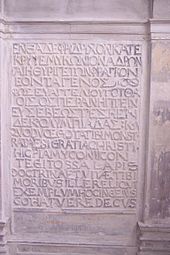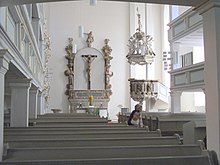Augustinian Church (Gotha)
The Augustinian Church in the old town of Gotha , formerly the monastery church of the Augustinian hermits , is now a Protestant parish church .
history

In 1216, Cistercian nuns founded a monastery in Gotha, which came into the possession of the Augustinian monks as early as 1258. They expanded the monastery and built a new church. After the Reformation and the dissolution of the Augustinian Convent, the church was rebuilt again in 1676 under Duke Ernst I by Andreas Rudolph and furnished in early baroque style until 1680 . It received two-storey galleries.
The most famous preacher in the Augustinian Church was the Augustinian monk Martin Luther , who stood here several times (including on April 8, 1521) in the pulpit.
In 1524 the church became Protestant.
On December 21, 1524, the reformer and Gotha superintendent Friedrich Myconius founded the Gotha grammar school, which had emerged from the Latin school and was given the addition Illustre (excellent, brilliant, famous) around 1600 by Duke Johann Casimir von Sachsen-Coburg . In the course of its existence, well-known school reformers and pedagogues such as B. Cyriacus Lindemann , Andreas Reyher , Friedrich von Schlichtegroll , Friedrich Jacobs and Johann Georg August Galletti . The Gymnasium Ernestinum , which still exists today (elsewhere), emerged from the Gymnasium Illustre in 1859 through the merger with the Ducal Realgymnasium .
The construction
The former monastery church is a hall church with a long choir , which, however, was shortened considerably in the 1930s. A winter church could be set up through the newly created space behind it. The exterior of the church is kept simple as a mendicant order church , and the church has no tower .
In 1939 the nave was shortened, that is, the altar wall was moved several column spacings into the church interior (the space gained in this way now contains the archive as well as rooms for community work on the floors above). The third gallery was also removed. The monumental (5.20 m wide and 8.70 m high) altar painting Calvary , created by court painter Paul Emil Jacobs in 1844 , was removed and stored; after decades of being forgotten, it was restored and received in 1998 as a gift in the Hohenleuben town church .
In air raids 1944-45 the church suffered lighter damage.
Furnishing
The equipment includes a Schmid-Böhm organ with an early Baroque prospectus, the royal box and the early Baroque pulpit. To the right of the altar, the gravestone of the reformer and Gotha superintendent Friedrich Myconius is set in the wall . The stone was transferred to the Augustinian Church after the old Gottesackers were abolished in 1874. The first part of his inscription, written by Johannes Stigel , is in Greek, the second in Latin. The translation of the Greek reads: “This is where Erde hid the capable Thuringian Friedrich Myconius, who was Franconian by origin. He lit the light of the gospel for the Gotha people, and godly he lived eleven Olympiads and the rest. ”The second, Latin part translates as:“ This stone covers the pious bones of Myconius, under whose guidance, Gotha, you the grace of Christ was shown. Through teaching and living, he has left you an example. Regard this, Gotha, as a great honor. "
The organ was built in 1993 by the organ builders Rudolf Böhm (Gotha) and Gerhard Schmid (Kaufbeuren) in the organ case of the Wedemann brothers from 1692. The slider chests -instrument has 49 registers on four manual stations and pedal . The game actions are mechanical, the stop actions are electric.
|
|
|
|
|
||||||||||||||||||||||||||||||||||||||||||||||||||||||||||||||||||||||||||||||||||||||||||||||||||||||||||||||||||||||||||
- Coupling : II / I, III / I, IV / I, III / II, I / P, II / P, III / P, IV / P
Augustinian monastery and cloister (extensions)
To the north of the church is the former Augustinian monastery, once the oldest in Thuringia. There is also the completely preserved Gothic cloister from 1366, which was built in the course of an expansion of the church in the same year. Along the walls are the gravestones and epitaphs of the following Gotha personalities:
- Johann Heinrich Erdmann (born December 10, 1664 in Waltershausen , † April 25, 1739 in Gotha), archdeacon since 1734
- Christoph Brunchorst (1604–1664), court preacher and consistorial assessor
- Rosina Elisabeth Gotter († April 1727), third wife of Ludwig Andreas Gotter
- Johann Franz Buddeus (1667–1729), councilor
- Salomon Glass (1593-1656), Superintendent General
- Karl Franz Buddeus (1695–1753), theologian, councilor and vice-chancellor of Duke Friedrich III.
- Peter Zacharias von Wölcker (1688–1726), commissioner of Duke Friedrich II.
- Heinrich Christian Mühlpfort (1702–1703), son Dr. Christian Hieronymus Mühlpforts
- Johann Georg August Galletti (1750–1828), professor at the Illustre grammar school and father of the catheter blossom , the side of the tombstone facing the wall is dedicated to his second wife Wilhelmine
Most of the tombstones and epitaphs come from the former cemetery I (also called Alter Gottesacker ) between Werderstrasse (today Bohnstedtstrasse) and Eisenacher Strasse. When the cemetery was cleared in 1904, they were moved to the cloister. In addition, there is an undated stone relief depicting Jesus crucified and an anonymous baroque tombstone with the Latin inscription HOMO BULLA MEMENTO MORI (Man is just a (water) bubble. Remember that you are mortal.)
Say
Two well-known Gotha legends are also linked to the Augustinian Church. The titled The Devil in the Church reports on a sermon by Martin Luther on April 8, 1521 in the church. During the reformer's sermon, the devil is said to have sat in the west gable and - angry that Luther stole so many souls from him - broke stones from the wall with a great bang in order to hurl them down into the nave. Luther, however, was not deterred by this, and as if by a miracle none of the numerous churchgoers was hit by the stones.
Tradition The walled-in Augustinian tells of a monk of the monastery who is said to have committed a serious offense against the rules of the order. To atone for his guilt, his confreres condemned him to be walled up alive in a niche in the so-called small courtyard of the monastery. At that point, the abbot had a stone face built into the wall as a permanent reminder to the brothers to adhere to the rules of the order. For many decades the spirit of the walled-in monk, who was unable to find peace even in death because of his misconduct, is said to have haunted the monastery at night. The ghost only disappeared when the small courtyard and with it the wall niche and the stone face disappeared during a renovation .
Additional information
It was Augustinian monks from Gotha who founded an Augustinian monastery in Grimma at the end of the 13th century , the church of which - at least as a building - still exists; From 1550 the monastery became the state and princely school Grimma , which is now home to the St. Augustin high school .
Web links
- Augustinian monastery in Gotha
- City parish of Gotha - parish of St. Augustin
- Visitor information about the church and cloister (PDF file)
Individual evidence
- ^ Hans-Jürgen Hinrichs: Latin and Greek inscriptions in Gotha and the surrounding area, Part I. Gotha, Ulenspiegel-Verlag, 1998; P. 44ff.
- ↑ Information on the organ , accessed on May 8, 2016
- ^ Philipp-Kaspar Pfannstiel: cloisters in stone preserved silence. Projekt-Verlag Cornelius GmbH, Halle, 2008, ISBN 978-3-86634-432-7 , p. 165
- ↑ Andreas M. Cramer, Die Gothaer Sagen , Gotha 2005, p. 32
- ↑ The devil in the church at www.echt-gothsch.de, accessed on May 8, 2016
- ^ Andreas M. Cramer, Die Gothaer Sagen , Gotha 2005, p. 16
- ↑ The walled Augustine on www.echt-gothsch.de, accessed on May 8, 2016
Coordinates: 50 ° 56 '50.4 " N , 10 ° 41' 58.1" E





